Key takeaways
- Real-time observation and audience feedback are essential for musicians to adapt performances and create memorable experiences.
- Different types of audience reactions, like sing-alongs and quiet reflection, can significantly influence future artistic choices.
- Tools like social media and sentiment analysis help quantify audience emotions and provide deeper insights into their experiences.
- Personal connections and shared moments among audience members enhance the overall enjoyment and emotional impact of live performances.
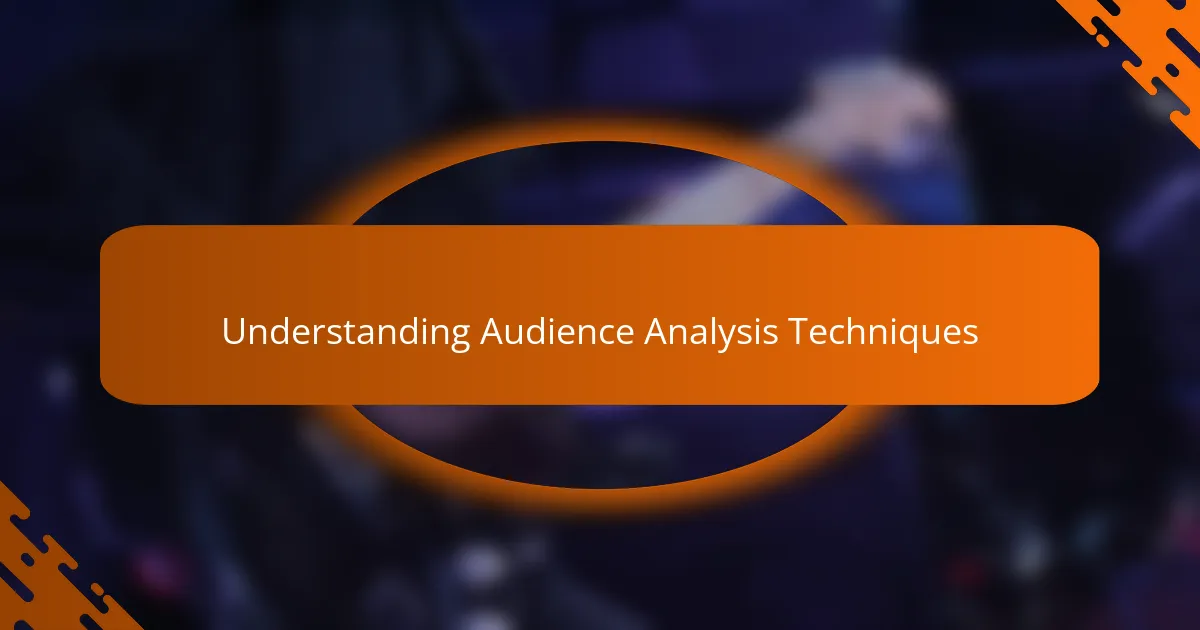
Understanding Audience Analysis Techniques
Understanding audience analysis techniques is crucial for any musician looking to connect with their fans. During my time at Bonnaroo, I observed how different performers gauged audience reactions through various methods. For instance, while some artists would immediately notice the energy in the crowd or the engagement level, others relied on social media interactions and feedback during or after their sets.
I always felt that the best musicians were those who could read the room. One artist I watched seemed to thrive on audience reactions, adjusting their performance in real-time based on the crowd’s vibe. This adaptability can make a significant difference in creating memorable experiences for both the performer and the audience.
Here’s a comparison of two common audience analysis techniques:
| Technique | Description |
|---|---|
| Real-Time Observation | Adjusting performance based on immediate crowd energy and reactions. |
| Post-Event Feedback | Gathering comments and reviews from social media and surveys after the show. |
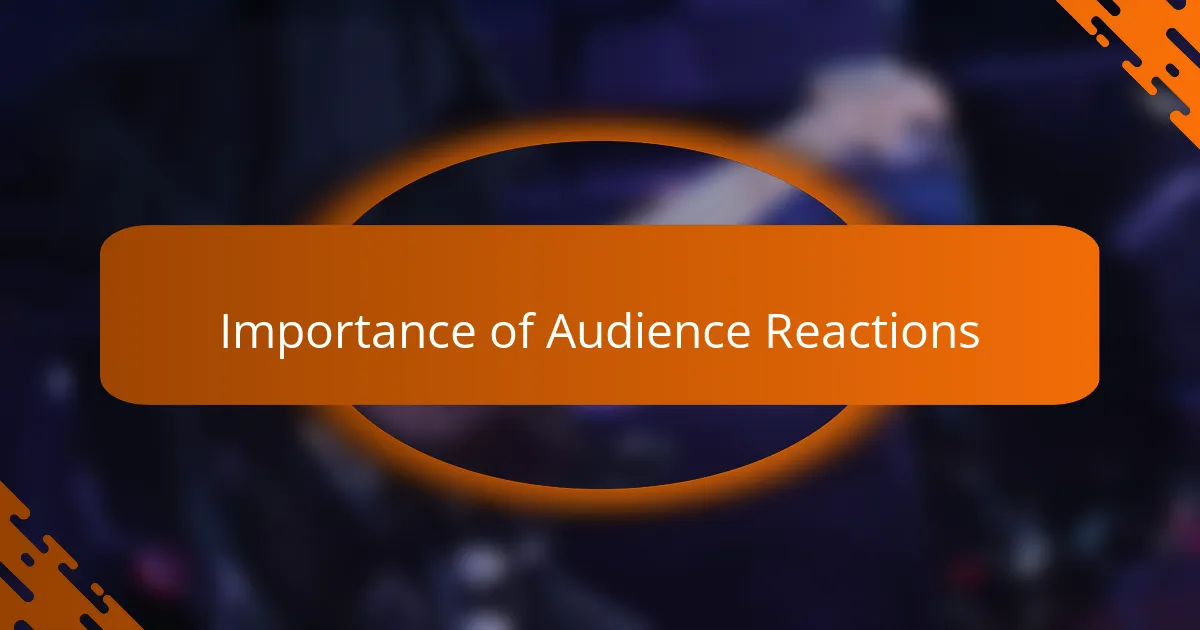
Importance of Audience Reactions
Analyzing audience reactions at events like Bonnaroo is crucial for a musician. It offers insights into what resonates with people, which can inform their artistic choices. During my experience at Bonnaroo, I felt the electric atmosphere shift with every song the artist played, making it clear which tracks truly connected with the crowd.
What really captivated me were the moments when the entire audience sang along. That unity is a powerful reminder that music is a shared experience. I realized that understanding these reactions helps shape future performances and build deeper connections with fans.
Here’s a comparison of different audience reactions based on my observations:
| Type of Reaction | Description |
|---|---|
| Sing-Alongs | Audience participation, creating a sense of community. |
| Quiet Reflection | Moments of stillness, indicating deep emotional connection. |
| Energetic Dancing | High energy and enthusiasm, showing enjoyment and engagement. |
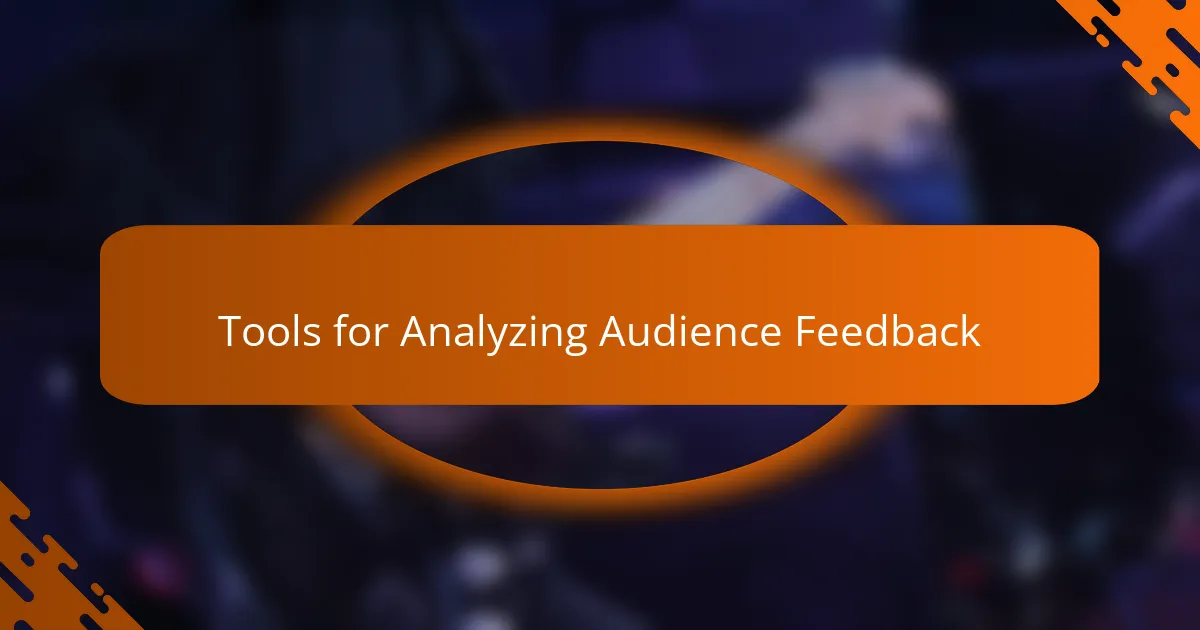
Tools for Analyzing Audience Feedback
When it comes to analyzing audience feedback, I found several tools to be incredibly effective. Social media platforms like Twitter and Instagram provided immediate reactions, showcasing the energy and excitement of the crowd in real-time. Additionally, post-show surveys helped me gather more in-depth insights, allowing fans to express their thoughts and feelings long after the performance ended.
Another tool I used was sentiment analysis software, which helped me quantify the emotions expressed in audience comments. I was surprised by how nuanced the feedback could be; some fans loved a particular song while others felt it was overplayed. This duality of responses offered me a deeper understanding of the concert experience and reinforced the importance of keeping playlists fresh and varied.
Incorporating these tools not only helped in assessing audience reactions but also made me feel more connected to the fans. Their feedback informed not just future performances, but also shaped the overall direction of my music career.
| Tool | Description |
|---|---|
| Social Media | Platforms like Twitter and Instagram for real-time audience reactions. |
| Post-Show Surveys | Collect in-depth feedback from fans after the concert. |
| Sentiment Analysis Software | Quantifies emotions in audience comments, revealing nuanced opinions. |
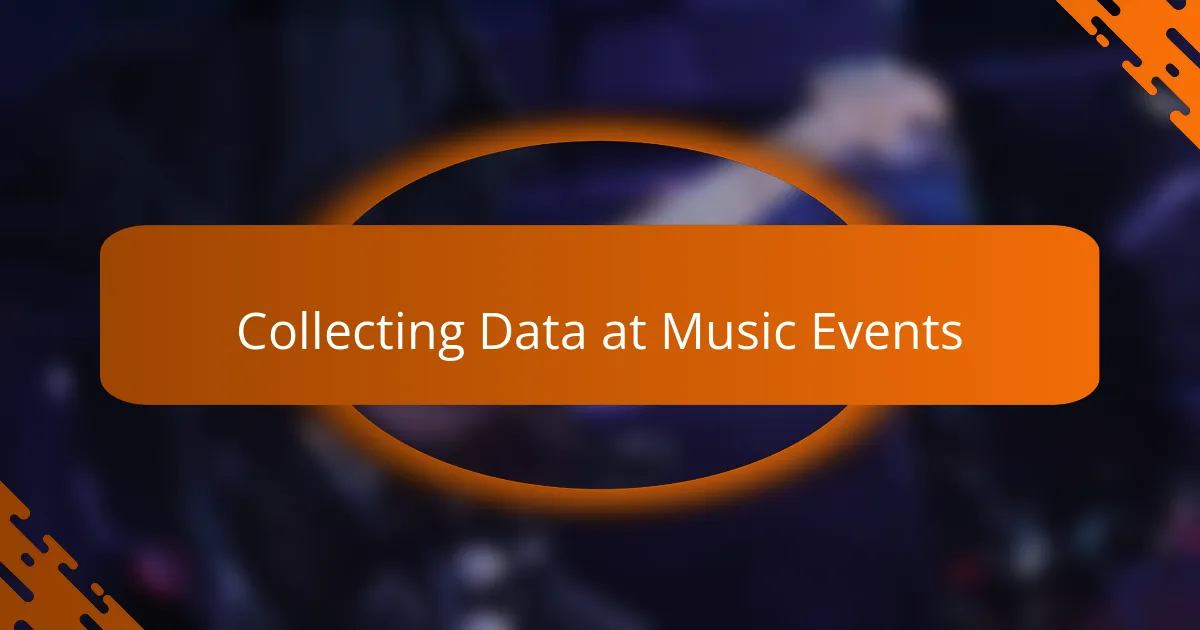
Collecting Data at Music Events
Collecting data at music events involves a mix of observation and engagement. At Bonnaroo, I often found myself observing how performers gauge audience reactions, not only through their own interactions but also by noting spontaneous crowd responses. For example, I remembered a moment when the crowd’s cheers surged during a surprise song, which sparked a palpable excitement that changed the entire atmosphere.
One technique I used was taking notes during performances. I would jot down the moments that ignited the crowd, like when everyone erupted in sing-alongs. These notes served as a powerful reminder of what truly resonated with fans. It made me wonder, how often do performers recognize these pivotal moments in real-time?
Since many concert-goers share their reactions on social media almost instantly, I discovered that reviewing their posts could capture the pulse of the audience. I was amazed by how insightful these snippets of feedback could be. They provided perspectives I might have missed while being immersed in the performance itself. The balance between real-time observation and post-event analysis can offer a well-rounded understanding of the audience’s experience.
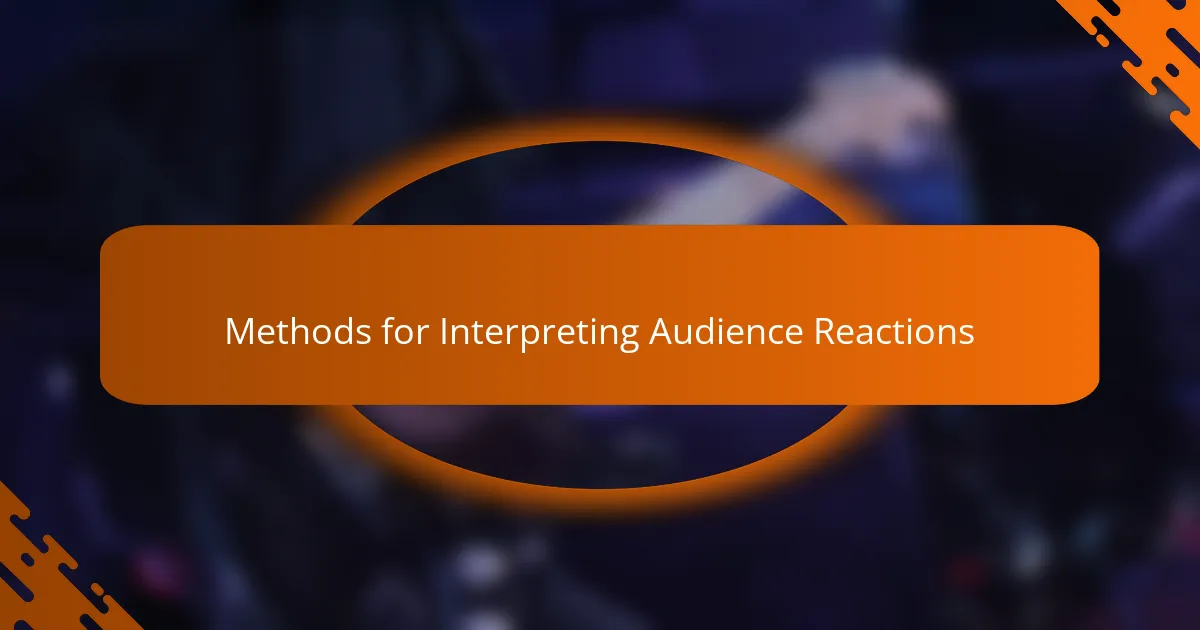
Methods for Interpreting Audience Reactions
Understanding how to interpret audience reactions enhances the connection a musician can create during a performance. I remember one evening at Bonnaroo when I stood among thousands, all of us vibing to the same rhythm. That binding energy is something that I wanted to capture and analyze. I began by observing real-time reactions—like how certain guitar riffs sent people into fits of ecstatic dancing, while others left them reflective and quiet. It was fascinating to see how different songs could trigger entirely different responses in the crowd.
Taking specific notes during performances became a method I relied on heavily. I would mark down not just the highs, like when the audience erupted in unison, but also the quieter moments when people seemed lost in thought. It made me realize—how often do we reflect on those still moments? They can be just as telling as the loud cheers. There’s often a depth in silence that speaks volumes about the emotional connection the music creates.
Listening to the chatter on social media after the shows was also invaluable. I found that audience members shared their inner thoughts long after the final note had faded. One post struck me deeply; a fan described how a particular song helped them through a tough time. It highlighted how, even if I couldn’t hear every individual voice during the performance, those digital conversations provided vital insights. This blend of immediate observation and reflective analysis allowed me to grasp the profound impact of a live experience.
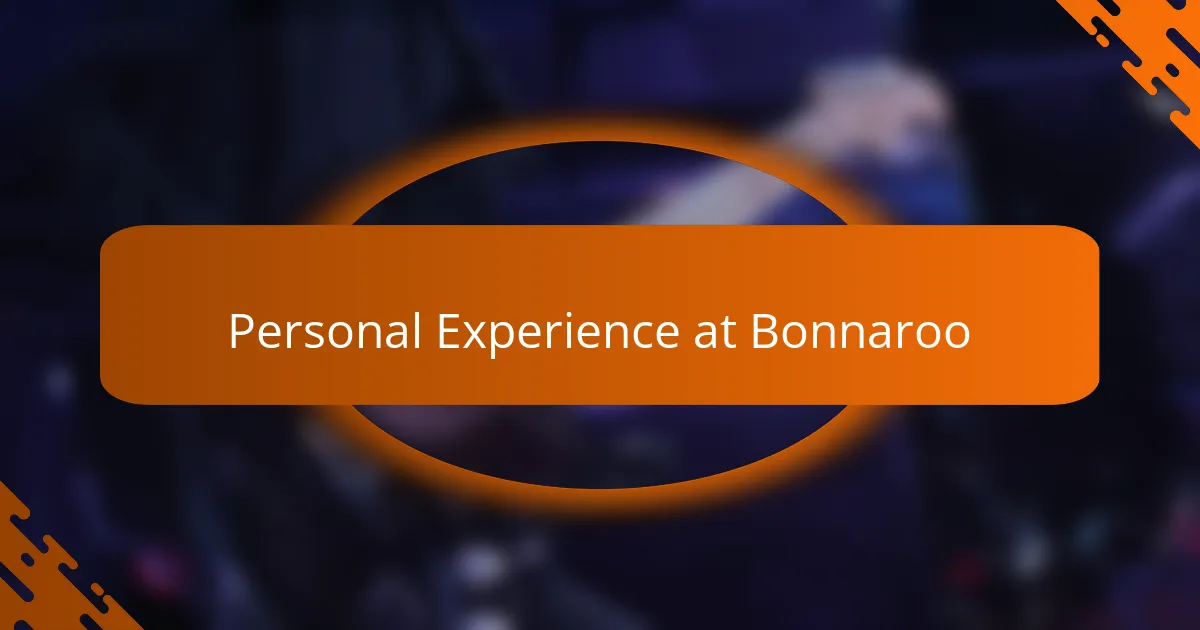
Personal Experience at Bonnaroo
The energy at Bonnaroo is absolutely contagious. I remember standing in the crowd, completely swept away by the music, surrounded by people lost in their own euphoric moments. I often found myself exchanging smiles and nods with strangers, and it struck me how music creates a shared experience that transcends individual backgrounds.
One unforgettable moment occurred during a late-night set when the crowd erupted into spontaneous singing. The joy and unity in that instant were palpable, and it became clear to me how important it is for musicians to connect with their audience on an emotional level. Here are some observations I made while analyzing the reactions of festival-goers:
- The diversity of the crowd amplified the richness of the experience.
- Emotional highs and lows were mirrored in the audience’s collective response.
- Small gestures of engagement, like eye contact from performers, heightened the connection felt among attendees.
- Group dynamics played a significant role in amplifying excitement or relaxation.
- Combining different music genres fostered unique reactions, showcasing the crowd’s adaptability.
These insights not only helped me understand audience behavior but also deepened my appreciation for the art of performance.